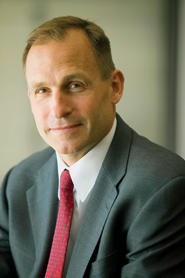Running a major buyside trading desk is challenging. But try doing it during a merger and pandemic.
That’s more akin to crisis management.
But not for market veteran Dan Royal, Head of Global Equity Trading at Janus Henderson Investors, representing the firm as winner of the 2020 Markets Media Market Choice Award for Best Global Trading Desk. Royal, whose career dates back to 1984, has been through virtually all that Wall Street could send his way – working all over the United States. He recently sat down with Traders Magazine to discuss how the desk evolved after its merger and rose to global dominance.
Traders Magazine: Describe the recent Janus/Henderson merger. Was there redundancies? Was there some restructuring? Philosophical changes?

Dan Royal: Following the merger announcement between Janus and Henderson, we recognized we had a more substantial global footprint than either legacy firm had previously. We had the benefit of significant geographical alignment, with both firms maintaining teams in London and Singapore, adding the well-established presence of the Denver desk gave Janus Henderson a true global coverage model for equity trading. We merged with a total of 24 equity traders globally, quickly sorting through the needs of our global footprint and assessing the aptitude of everyone’s willingness to harmonize. Through a difficult period, we established the global team of 16 equity traders across the three regions.
We established the motto of ‘Global First.’ We recognize that regional distinctions are inevitable, yet an overarching global philosophy is essential. We made a point to not keep score on systems, workflows or personnel, recognizing that compromise will occur throughout the process. The mindset of legacy workflows, while important, were challenged throughout the process to maintain an open minded approach to our path forward.
Our goal was to quickly achieve a singular platform within the complexities that each firm brought to the table, where harmonizing on a common OMS, EMS and TCA platform facilitated a team atmosphere and had us speaking the same language early in the process. Knowing some these systems required future upgrades or functionality reviews, the prospect of harmonization didn’t seem as daunting. We also felt it was important to get key personnel interacting face to face as early as we could. We made point of sending traders across regions for greater appreciation of the demands on each desk and the familiarity of folks on the other end of the line. We continue to have weekly schedules calls across each regional head.
Lastly, we established a number of global initiatives spanning, bracketed algo structure, system improvement, workflow efficiencies, policy review and focused on improving our reporting capabilities. Across a dozen global initiatives, we assigned a point person from each region to work collectively across borders to advance their project(s). This last initiative truly help solidify the global nature of this department and garner a very productive alliance across desks.
TM: Describe managing a global trading desk today? Has it gotten harder with technology or easier?
Royal: Managing a global trading operation can be a complex task, given a market and regulatory structure that continues to evolve. We are extremely fortunate to have a sensible mix of industry experience within our individuals, yet the level of senior level expertise is unmatched. Half of our team globally either has or had the role of desk head within their career. It’s that level of maturity and industry exposure that has really helped this team become an example of what’s possible for a firm’s global success. Technology facilitates greater efficiencies and connectivity, yet selecting and adopting new technological solutions creates its own challenges. It ultimately becomes the proper balance of focused and engaged members of the team, equipped with the proper technology solutions will yield success. An overcompensation in one, won’t necessarily offset a deficiency in the other.
TM: How has the shift to remote trading thanks to COVID 19 been? Is there a particular technology that has made it easier or difficult?
Royal: I am amazed at how the industry has holistically responded to the COVID crisis and such a relatively seamless fashion. To move roughly 80 or 90 percent of the industry workforce into a dispersed work environment during unprecedented levels of market volatility and liquidity demand, is astonishing. It’s an incredible achievement by all of the industry’s brokers, exchanges, vendors, asset managers and regulators that comprise the infrastructure of this industry. Had this event happen even a few years ago, I do not think we would have navigated these events so smoothly, as an industry.
TM: Do you miss the camaraderie of the desk? How would you quantify the human touch of trading now that we’ve gone electronic or remote?
Royal: I absolutely miss the camaraderie. We are fortunate though, that equity trading is one of the few departments utilizing the firm’s onsite facilities. While not possible in every location and still dispersed in locations where it is, team members have direct access to the network and greater collaboration among the small working pods. That said, work from home is utilized by nearly half of the global department and the workflow is largely seamless.
The human element of our team’s involvement in handling our order flow is critical. Obviously, the electronic nature of how orders are handled via our EMS, OMS and integrated systems, remain unchanged.
TM: What advice would you give to other senior trader on building out a global trading desk?
Royal: Global alignment is critical. Operate as a harmonized unit where members all work toward common objectives across geographic borders. It not only develops a sense of camaraderie, yet introduces any regional nuances into the initiative early in the process with the intent of finding solutions that suit the team as a whole.





